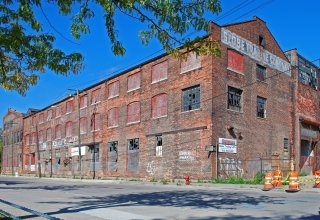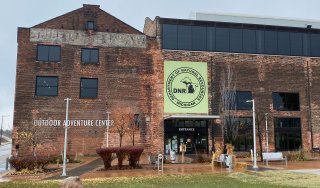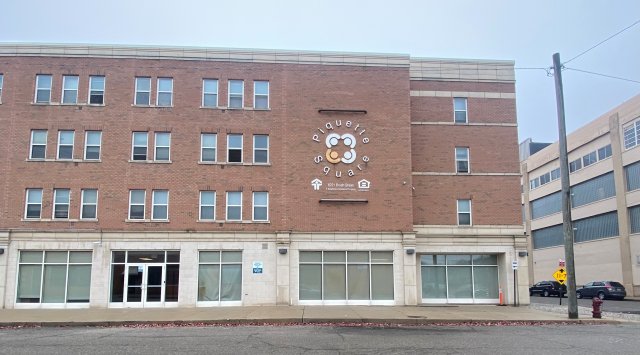Brownfield Redevelopment in Detroit
On this page:
- Michigan Department of Natural Resources Outdoor Adventure Center
- Orleans Landing
- Elevator Building
- Detroit Riverwalk
- Piquette Square
- Cardinal Health Medical Warehouse
U.S. EPA’s Brownfields Assessment and Cleanup Grant Program played an important role in the on-going redevelopment of the Detroit riverfront east of downtown. Michigan’s first urban state park, popular cultural attractions, and new residences and businesses continue to expand in this formerly industrial section of the city. The Detroit River Conservancy estimates $275 million have already been invested along the riverfront with an additional $1 billion expected to be invested in the next decade.
Michigan Department of Natural Resources Outdoor Adventure Center

Located on Detroit’s riverfront in the historic Globe Building, the Outdoor Adventure Center, or OAC, gives Detroit residents a taste of Michigan’s great outdoors in the heart of the city. In 2016, its first full year of operation, the OAC saw 100,000 visitors.
A $15 million renovation revitalized this former dry dock. The Globe Building had an important role in Great Lakes maritime history as a manufacturer of marine steam engines for freight and passenger vessels. Henry Ford worked at Detroit Dry Dock Engine Works from 1880-1882 as an apprentice machinist, learning the skills associated with his first love, steam-powered engines.

The city of Detroit made the first investment in the OAC project using $200,000 from the Brownfields Assessment and Cleanup Grant Program to remove contaminated soils on the site.
20 Jobs Created
$15 Million Redevelopment Investment
Orleans Landing
Construction is near completion on the $65 million, 270-apartment Orleans Landing complex. Located immediately next to the Outdoor Adventure Center, the 270 unit Orleans Landing Apartments gives Detroiters the opportunity to enjoy the redeveloped neighborhood. When completed in 2017, the development represented the first market-rate residential construction project on Detroit’s East Riverfront in 25 years. An EPA Brownfields Assessment and Cleanup Grant to the Detroit Wayne County Port Authority, or DWCPA, funded the environmental investigation needed to demonstrate the feasibility of residential construction on the site.
33 Jobs Created
$61 Million Redevelopment Reinvestment
Detroit Elevator Building

Once an old warehouse, the Elevator Building has been redeveloped into loft-style office space for small businesses. An EPA Brownfields Assessment and Cleanup Grant to the DWCPA was used to identify hazardous materials that were subsequently managed during building renovations.
2 Jobs Created
Detroit Riverwalk

The riverfront was mainly an industrial and warehouse district for most of the 19th and 20th centuries. Now, more than 3 million people a year use the Detroit RiverWalk, the pedestrian/bike path that runs along the river from Belle Isle to Rosa Parks Boulevard. It’s one of downtown’s most popular attractions. The DWCPA conducted the necessary environmental investigations using its EPA Brownfields Assessment and Cleanup Grant Program funding.
Piquette Square
Formerly the site of an abandon Studebaker plant, the Piquette Square development in Detroit provides 150 apartments to house and care for homeless veterans. In addition to shelter, the project offers space for a wide range of support services to help veterans develop self-sufficiency to reintegrate into the community. Southwest Housing Solutions developed and manages the facility which opened for occupancy in June 2010.

The project’s success required financial assistance from numerous government agencies and charitable organizations. U.S. EPA’s Brownfields Assessment and Cleanup Grant Program provided the funds needed to investigate and remediate contamination resulting from the sites industrial past and the fire which destroyed the Studebaker plant. The Detroit Wayne County Port Authority, or DWCPA, used part of its Brownfields Assessment and Cleanup Grant to evaluate the nature and extent of environmental problems at the site. Then, the Wayne County Brownfield Redevelopment Agency provided a loan from its brownfield revolving loan fund to Southwest Solutions to clean up contaminated soils, remove underground storage tanks, and install a vapor intrusion barrier.
Construction of the $23 million facility was financed by tax credits, bond funds, a state program to end chronic homelessness, and other various grants. U.S. EPA’s Brownfields Assessment and Cleanup Grant Program funding was particularly important as it was the only source of project money available for environmental investigation and cleanup.
Notable Project Features:
- Redevelopment of abandon auto facility
- EPA funding provided by two different grantees working cooperatively
- Overcame state housing agency concerns about developing residential use on formerly contaminated property.
- Winner of 2011 Phoenix Award for Brownfield Redevelopment
Cardinal Health Medical Warehouse

A $1 million Brownfield Revolving Loan Fund grant to the DWCPA figured prominently in the development of the $30 million, 275,000 square-foot Cardinal Health medical warehouse. At full employment, the LEED Silver certified warehouse will provide 140 new jobs in the economically devastated, 18-acre, New Center neighborhood. LEED certification is a globally recognized symbol of sustainability achievement and leadership by the U.S. Green Building Council.
Both the development and environmental aspects of the project were complicated. The 18 acres consisted of 98 separate parcels with title defects on nearly every property.
Numerous roads had to be abandoned and reclassified, railroad spurs were pulled up, and 18 existing structures needed to be demolished.
Contaminated soil needed to be mitigated, 11 underground storage tanks removed, 11 underground storage tanks and underground tunnels were removed, and the largest soil vapor ventilation system east of the Mississippi needed to be installed. It was difficult for potential lenders to visit due to broken sidewalks, no working streetlights, and feral dogs that roamed the site.
The warehouse represents the first project in the South Campus Park. Henry Ford Health System has plans for residential, retail, and commercial development on the 300 acres it owns adjacent to its main hospital.
